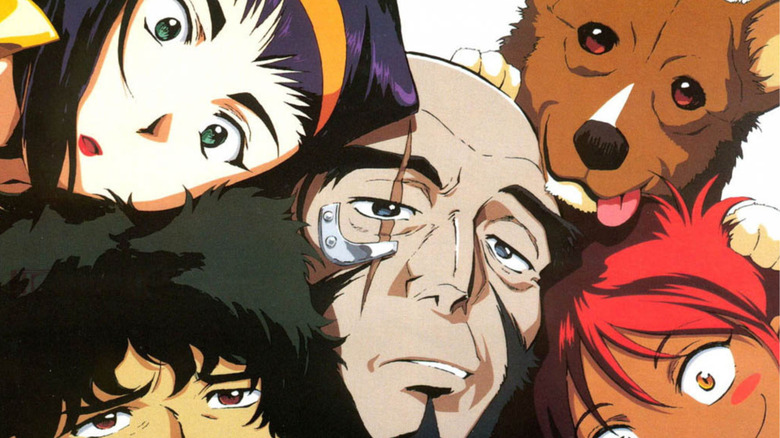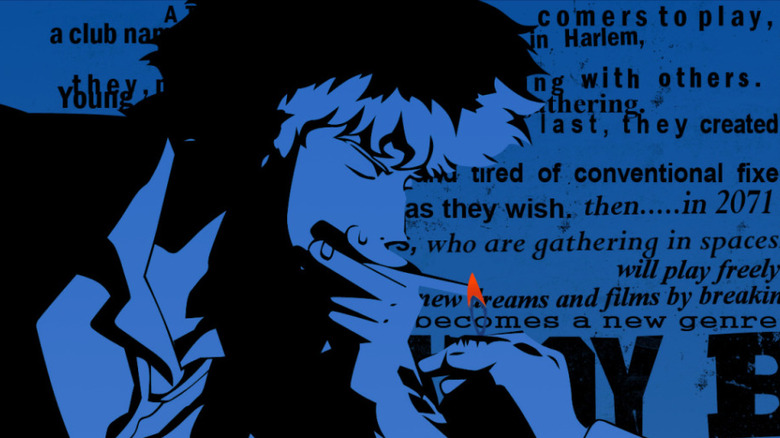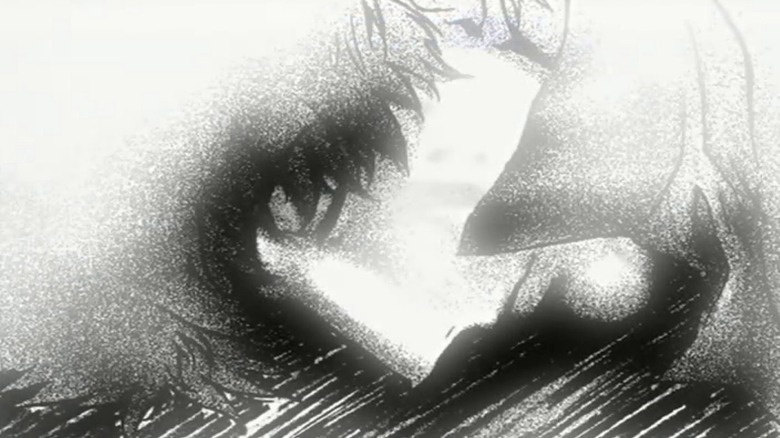How The Cowboy Bebop Team Tried To Make Every Episode Feel Unique
Part of the tragedy of "Cowboy Bebop" is how the main characters are so weighed down by their pasts that they're unable to live in the present. The creative team behind the classic anime series didn't share this attitude though. When making the series, "Hajime Yatate" (their collective pseudonym) were all focused on the present, not what lay behind or ahead of them.
Series director Shinichirō Watanabe and producer Masahiko Minami discussed their episode-by-episode attitude at a roundtable for the show's 20th anniversary, held at French convention Japan Expo 2018. Watanabe recounted (transcribed by SakuraBlog):
"I had an episodic series in mind from the get-go. I wanted every episode to feel fresh. And all the aforementioned problems we encountered only reinforced that vision of the series I had... But we still needed a thread, albeit thin, common to all episodes for the setting, world elements, characters, etc."
Those thin threads wound up being (a.) the characters hunting bounties and (b.) confronting faces from their pasts. However, even these storylines lent themselves well to the series' episodic format. This approach was solidified by the crew treating every episode like its own standalone story, and allowing all sorts of staff members to pitch in.
A mishmash team effort
The "Cowboy Bebop" opening sequence, "Tank!" by the Seatbelts, contains a bold declaration hidden in its scrolling text animation: "the work that becomes a new genre itself will be called... Cowboy Bebop." On a macro and micro level, "Bebop" mixes so many influences it defies categorization.
The setting may be science fiction, but true to the "Cowboy" part of the title, there's Western influence too: the Solar System is a newly-settled, lawless frontier. The character archetypes owe more to Film Noir — Spike's a former criminal, Jet an ex-cop, Faye a wannabe femme fatale. Yoko Kanno's music score is as eclectic as the storytelling. "The Real Folk Blues" mixes jazzy saxophone riffs with lyrics out of a lovelorn ballad.
Episode by episode, widely different tones are explored. "Black Dog Serenade" is one of the show's darkest chapters, explaining how Jet lost his right arm thanks to his corrupt ex-partner, Fad. The very next episode, "Mushroom Samba," is the show's silliest, featuring the adventures of comic relief character "Radical" Edward and pet "data dog" Ein while the rest Bebop crew accidentally get high on psychedelic mushrooms. While "Serenade" is a hardboiled noir, "Samba" is a love-letter to 70s stoner and blaxploitation movies — a woman who suspiciously resembles Pam Grier even shows up.
At the Japan Expo panel, Watanabe mentioned how the team enlisted different staff members for every episode to ensure each was unique. Dai Sato, a totally green writer, scripted two "Cowboy Bebop" episodes, while Minami broke out of his producing role and worked directly on episode 10; he gave the episode an "enka"-inspired tone.
If you make every episode feel different, you risk creating an unbalanced series. However, "Cowboy Bebop" begins as such a unique creation that introducing a new ingredient never upsets the flavor.
Making every episode like it was the last
Watanabe acknowledged there was another reason they made "Cowboy Bebop" episodic:
"Every episode was written like it was the last because we knew the series may be called off any time."
This attitude helps explain episode 11, "Toys in the Attic." In that "Alien" parody, the Bebop crew is picked off one-by-one by a poisonous blob creature. The episode ends with everyone unconscious except for Ed, who beats the creature by eating it. In the preview for the next episode, Ed claims everyone died, "Bebop" is over and the next show will be "Cowgirl Ed." Of course that isn't true and everyone's fine in episode 12. If the series had ended there, what a wild ending it would've been.
Watanabe's fears of a premature end weren't simple paranoia. For starters, "Cowboy Bebop" had trouble getting funding. The series' sponsor Bandai just wanted sell spaceship toys, but pulled back thanks to the offbeat narrative that Sunrise designed for their toy commercial. If subsidiary Bandai Visual hadn't stepped in, "Cowboy Bebop" may not have gotten off the ground.
Plus, the series was yanked off the air at one point. TV Tokyo aired only 12 "Bebop" episodes (and a clip show) from April 3 to June 26, 1998. Thankfully, the series soon aired in its entirety on Wowow, from October 24, 1998 until April 3, 1999. When "Cowboy Bebop" made its way to the U.S., airing on Adult Swim in 2001, its reputation as a classic was solidified. The series' episodic approach and heavy western influence made it accessible to American audiences, who weren't as well-versed in anime then as they are now.
By putting care into each episode, Watanabe, Minami, and their Sunrise teammates created something even greater than the sum of its unique parts.


